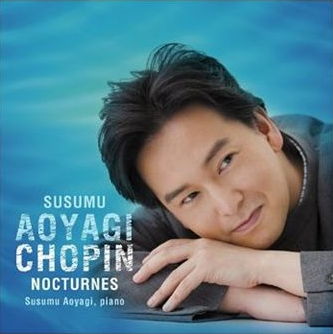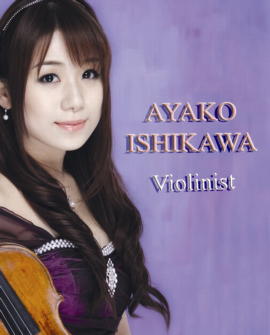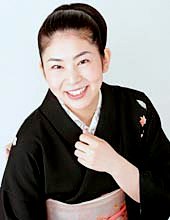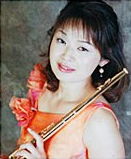|

True Artistry
HOWARD SMITH attends New Zealand's
Music Fair of Japan 2009
Joint, formidably gifted music-making by four young Japanese instrumentalists swept through Ilott Theatre [Friday 10 July 2009, Wellington, New Zealand] like a refreshing breath of cherry blossom and clean, 'green', bracing Wellington air.
This was the first of two such concerts held as part of Japan Festival Wellington (6-11 July) organised by the Embassy of Japan, Asia NZ and Absolutely Positively Wellington.
A capacity Friday audience embraced large numbers from New Zealand's Japanese community while dignitaries included Ambassador to New Zealand, Toshihiro Takahashi, and Wellington Mayor Kerry Prendergast.
Pianist Susumu Aoyagi began the programme with a Chopin bracket and overall, throughout the concert, as both soloist and accompanist he displayed striking clarity and expressive power.

Susumu Aoyagi
|
A rapt silence descended with his heartfelt performance of Chopin's Nocturne in C sharp minor, Op posth, heard in Polanski's film The Pianist, the story of Wladyslaw Szpilman, featuring Adrien Brody in the title role.
The spell continued through Nocturne No 2 in D flat major, Op 27, only to be dispelled by Chopin's whirlwind Etude No 11, Op 25 -- a ferocious stormy performance.

Ayako Ishikawa
|
For her opening item, Ayako Ishikawa chose what is arguably the best-known yet least played Csárdás in the violin repertory -- by Vittorio Monti (1868-1922), at one time conductor of the Lamoureux Orchestra. While this Csárdás was dexterously accomplished, it remains a slender example of true 'roma' style.
To leave the audience eager for more during interval time, Aoyagi powered through Liszt's 'blistering' Hungarian Rhapsody No 2 with exhilarating results -- no wonder a piano tuner was kept busy with the Steinway at intermission.
The programme resumed with 'Variations on Sakura, Sakura' by Tadao Sawai (1938-1997) in which the wonderful koto artist Lisa Kataoka held her Wellington audience spellbound.

Lisa Kataoka
|
However, to my mind, the standout Japanese item was Haru no Umi (literally 'Spring Sea') -- an evocation of the Seto Inland Sea written for shakuhachi and koto in 1929 by blind koto master Michio Miyagi (1849-1956). In 1932 French violinist Renee Chemet toured in Japan and after hearing Miyagi perform Haru no Umi, the visitor arranged the shakuhachi part for violin. Subsequently Chemet and Miyagi recorded it for distribution in Japan and Europe.
It was this arrangement Wellingtonians were privileged to hear so affectionately presented by Ishikawa and Kataoka.
Jo Hisaishi (born 1950) is best known for his (animation) soundtrack and Departures -- an item for piano, flute, violin and koto clearly betraying its filmic nature. Departures ('Okuribito') is a 2008 Japanese film by Yojiro Takita. It won the Academy Award for Best Foreign Language Film at the 2009 Oscars and has earned US$ 61,010,217 in Japan as of 12 April 2009.
Massenet's 'Thaïs' Méditation with Ishikawa and Aoyagi was fluid and winsome; far preferable to the plodding, dirge-like early recording of Nigel Kennedy. This perennial operatic favourite showed the firm sweet tone of Ms Ishikawa's violin -- a rare Bartolomeo Bimbi dating from 1762/3.
During the second half of the eighteenth century, Bimbi was active in Sienna and Florence and typically his violins are small in pattern, high built, and finished with eye-catching red-orange varnish.
Though Ishikawa's demonic adaptation of Saint-Saëns' Danse Macabre (1875) was somewhat more literal than that of the composer's convoluted violin and piano version (included on Cedille Records' Instrument of the Devil with violinist Rachel Barton Pine and pianist Patrick Sinozich, CDR 90000 041), the Japanese virtuoso's frenzied eerie dance proved doubly effective and its effortless bravura was positively spine chilling.

Takako Hagiwara
|
Aoyagi returned with Takako Hagiwara to perform Ai Sansan written by composer and banker Kei Ogura (born 1944) for beloved Japanese enka singer and actress Hibari Misora (1937-1989):
Ame san san' to kono mi ni ochite
Wazuka bakari no un'no warusa wo
Urandari shite
Hito wa kanashii kanashii mono desune
Sorede mo kako tachi wa
Yasashiku matsuge ni ikou
Jinseitte fushigi na mono desune.
Finally, Carmen Fantasie 2001, Hagiwara's arrangement of themes from Bizet's opera, bore more than a passing resemblance to Pablo de Sarasate's transcription for violin and orchestra (1883). Whatever the case, Ms Hagiwara's dazzling performance was an outright tour de force, marking her out as a top flutist of the future.
To express their appreciation for the New Zealand audience, all four artists played Now is the Hour -- a maudlin, 'cringe-worthy' NZ (?) favourite, often described as a traditional Maori song.
In fact it first became known in Australia (in 1913) when it was published as piano-variations by the Dutch/Australian W H Paling and Co. Its earlier incarnation was as the Swiss cradle song by Isabel Varney Desmond Monk (1892-1967) and later (in a version for B flat cornet and violin) credited to influential English theatre critic and travel writer Clement Scott.
The least said about Now is the Hour, the better.
What emerges most clearly is that Wellingtonians have reason to be thankful for Japan Festival's evenings of undemanding musical treasures, performed with such finesse, fire and sovereign artistry.
Copyright © 14 July 2009
Howard Smith,
Masterton, New Zealand

| 
